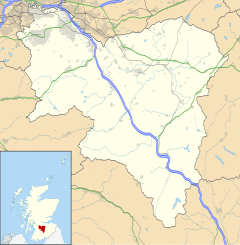East Kilbride, Scotland
East Kilbride
|
|
|---|---|
 Kilbride parish church tower |
|
| East Kilbride shown within South Lanarkshire | |
| Population | 74,411 |
| OS grid reference | NS635545 |
| Civil parish |
|
| Council area | |
| Lieutenancy area | |
| Country | Scotland |
| Sovereign state | United Kingdom |
| Post town | GLASGOW |
| Postcode district | G74-75 |
| Dialling code | 01355 & 0141 |
| Police | Scottish |
| Fire | Scottish |
| Ambulance | Scottish |
| EU Parliament | Scotland |
| UK Parliament | |
| Scottish Parliament | |
East Kilbride (Scottish Gaelic: Cille Bhrìghde an Ear) is the largest town in South Lanarkshire in Scotland. It was also designated Scotland's first new town on 6 May 1947. The area lies on high ground on the south side of the Cathkin Braes, about 8 miles (13 km) southeast of Glasgow and close to the boundary with East Renfrewshire.
The town is enclosed by the White Cart River to the west and the Rotten Calder to the east, the latter flowing northwards to join the River Clyde near Cambuslang. This area was previously the site of the small village of East Kilbride, prior to its post-war development.
The earliest evidence of habitation in the area dates back to ancient graves found near the Kype Water to the south of the district. Roman coins and footwear have also been found in the area.
East Kilbride takes its name from an Irish saint named St Bride (or Brigit), who founded a monastery for nuns and monks in Kildare in Leinster, Ireland, in the 6th century. Dál Riatan monks introduced her order to Scotland. The anglicisation Kil takes its root from the early Celtic monastics that St. Brigit is representative of: the Culdees or Céli Dé. The Céile Dé were 'the clients or companions of God'. In modern Gaelic, Cille Bhrìghde translates similarly as 'the clients or companions of Brigit'.
The original parish church was located on the site of a pre-Christian sacred well, which is possibly the origin of the association with St. Brigit, since the well was dedicated to the Celtic goddess Brigid, whose traditions have been continued through the reverence of St. Brigit. Over the centuries, the church has been destroyed and rebuilt several times, and, as a result, its current location has moved from the original site by about 50 metres (160 ft).
...
Wikipedia

